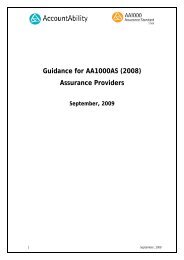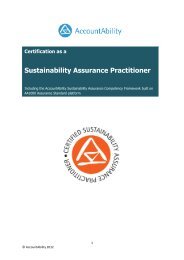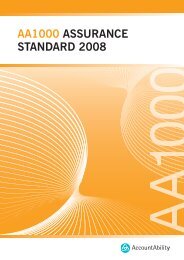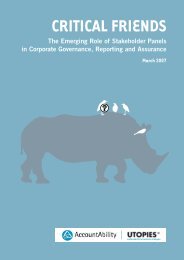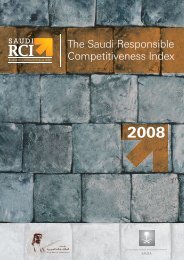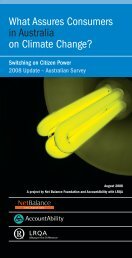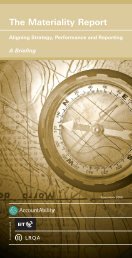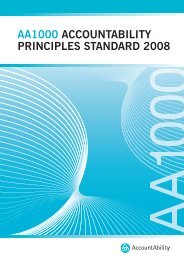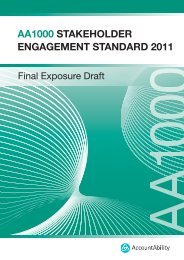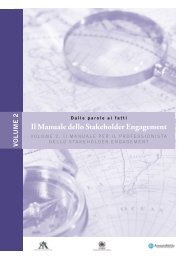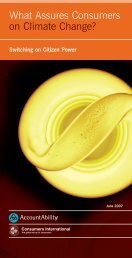The Stakeholder Engagement Manual Volume 2 - AccountAbility
The Stakeholder Engagement Manual Volume 2 - AccountAbility
The Stakeholder Engagement Manual Volume 2 - AccountAbility
Create successful ePaper yourself
Turn your PDF publications into a flip-book with our unique Google optimized e-Paper software.
Thinking about Assurance (continued)<br />
Consideration<br />
Assurance Providers<br />
Who provides the<br />
assurance?<br />
What competencies<br />
are needed to provide<br />
assure the<br />
stakeholders?<br />
Which level of<br />
assurance should be<br />
sought?<br />
Options<br />
STAGE 5<br />
Internal Assurance: functional areas, risk assessment/internal audit, or board level.<br />
External Assurance: audit professionals, CSR specialists, civil society organisations,<br />
opinion leaders, or advisory panels.<br />
Credibility/stakeholder representation:<br />
Assurance competency: checking data and analysing systems, and understanding<br />
assurance roles.<br />
Process competency: communicating with stakeholders, determining materiality and<br />
responsiveness.<br />
Substantive/content competency: social, scientifi c, economic or industrial expertise.<br />
Under ISAE3000 the level of assurance is understood as an evaluation aimed at reducing<br />
the risk of errors or omissions in the assured information to an acceptable level. ISAE3000<br />
differentiates between two levels of assurance:<br />
• “Reasonable assurance engagement” (risk reduced to a low level) and<br />
• “Limited assurance engagement” (risk reduced to a moderate level)<br />
A combination of these for different information or issues is also possible. <strong>The</strong> choice<br />
determines the amount and depth of work which the assurance provider undertakes and<br />
determines the wording in the assurance statement.<br />
AA1000AS argues that the assurance level to be pursued for the assurance assignment/<br />
process/ engagement is dependent on the following factors:<br />
• <strong>The</strong> availability of data<br />
• <strong>The</strong> robustness of the management systems<br />
• Existing Assurance for specifi c aspects of performance<br />
• Internal assurance processes<br />
• Resources allocated for assurance by the reporting organisation<br />
• Legal or commercial constraints<br />
• Competencies of the assurance provider.<br />
PLEASE NOTE<br />
Assurance is a complex subject, and the above discussion of it is necessarily<br />
limited. For further information please refer to the further resources on assurance<br />
provided in the appendix.<br />
THE PRACTITIONER'S HANDBOOK ON STAKEHOLDER ENGAGEMENT | 131



